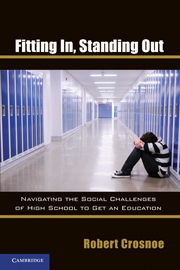Book contents
- Frontmatter
- Contents
- Acknowledgments
- PART I HIGH SCHOOLS AS CONTEXTS OF DEVELOPMENT
- 1 Pressures on Teenagers and Their Schools
- 2 A Day in the Life
- 3 The Two Sides of High School
- 4 Updating and Expanding Our Perspective
- PART II A CASE STUDY OF SOCIAL AND ACADEMIC EXPERIENCES IN HIGH SCHOOL
- PART III HELPING TEENAGERS NAVIGATE HIGH SCHOOL
- Works Cited
- Index
1 - Pressures on Teenagers and Their Schools
Published online by Cambridge University Press: 05 June 2012
- Frontmatter
- Contents
- Acknowledgments
- PART I HIGH SCHOOLS AS CONTEXTS OF DEVELOPMENT
- 1 Pressures on Teenagers and Their Schools
- 2 A Day in the Life
- 3 The Two Sides of High School
- 4 Updating and Expanding Our Perspective
- PART II A CASE STUDY OF SOCIAL AND ACADEMIC EXPERIENCES IN HIGH SCHOOL
- PART III HELPING TEENAGERS NAVIGATE HIGH SCHOOL
- Works Cited
- Index
Summary
These are definitely not the glory days of the American educational system. Schools have been stung by a steady stream of testing data showing a large achievement gap between American students and teenagers in other countries. Demographic changes have led to the proliferation of overcrowded classrooms and increased demand for special services for many new and expanding segments of the student population. No Child Left Behind and other educational policies have ratcheted up accountability standards and imposed a series of increasingly harsh sanctions all the way up to school closing. Simultaneously, funding has been cut to the point that many school districts face major budget shortfalls. Against this backdrop, bemoaning the state of American education and, in particular, criticizing teachers have become major discussion points in electoral politics and media debates. Such challenges have placed enormous pressures on schools and fueled a sense of pessimism – some of it warranted, some of it not – in the public at large.
In the face of these major financial, curricular, and organizational pressures on the educational system as a whole, the everyday pressures that teenagers encounter as they navigate the social worlds of American high schools seem far less important. Indeed, in the minds of many, helping teenagers cope with the social ups and downs of high school life does not rise to the level of pressing task when compared to the larger-scale challenges of raising school performance and effectively educating a new generation for entry into the global economy.
- Type
- Chapter
- Information
- Fitting In, Standing OutNavigating the Social Challenges of High School to Get an Education, pp. 3 - 21Publisher: Cambridge University PressPrint publication year: 2011



